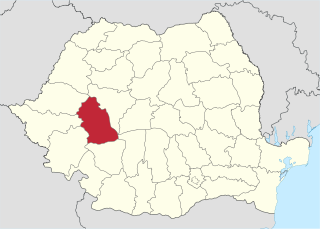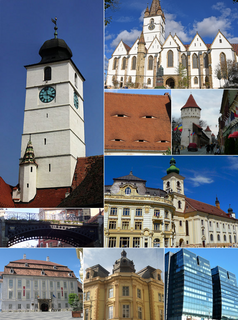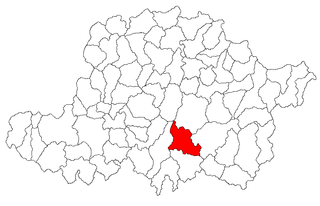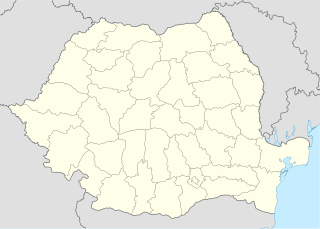
Bihor County is a county (județ) of Romania, in Crișana. Its capital city is Oradea.

Brașov County is a county (județ) of Romania, in Transylvania, with the capital city at Brașov. The county incorporates within its boundaries most of the Medieval "lands" (țări) Burzenland and Făgăraș.

Maramureș County is a county (județ) of Romania, in the Maramureș region. The county seat is Baia Mare.

Hunedoara County is a county (județ) of Romania, in Transylvania, with its capital city at Deva. The county is part of the Danube–Criș–Mureș–Tisa Euroregion.

Aiud is a city located in Alba county, Transylvania, Romania. The city's population is 22,876. It has the status of municipality and is the 2nd-largest city in the county, after county seat Alba Iulia. The city derives its name ultimately from Saint Giles (Aegidius), to whom the first church in the settlement was dedicated when built.

Sibiu is a city in Romania, located in the historical region of Transylvania. Located some 275 km (171 mi) north-west of Bucharest, the city straddles the Cibin River, a tributary of the river Olt. Now the capital of the Sibiu County, between 1692 and 1791 and 1849–65 Sibiu was also the capital of the Principality of Transylvania.

Pont-Audemer is a commune in the Eure department in the Normandie (Normandy) region in northern France. On 1 January 2018, the former commune of Saint-Germain-Village was merged into Pont-Audemer.

Gouttières is a commune in the Puy-de-Dôme department in Auvergne in central France.

The Crișul Negru (Romanian), is a river in western Romania (Transylvania) and south-eastern Hungary. The river has its source in the western Apuseni Mountains. It flows through the towns Ștei and Beiuș in Romania. Crossing the border of Hungary the river, now called Fekete-Körös, joins the Fehér-Körös a few kilometres north from Gyula to form the Körös river. In Romania, its length is 164 km (102 mi) and its basin size is 3,820 km2 (1,470 sq mi). Part of the water from the river Crișul Repede is diverted towards the Crișul Negru by the Criș Collector Canal.

Conop is a commune located in Arad County, Romania. Conop is situated at the southern foot of Zărand Mountains, in the Mureș Couloir. The commune stretches over 5420 ha and it is composed of five villages: Belotinț (Belotinc), Chelmac (Maroseperjes), Conop, Milova (Milova) and Odvoș (Odvos).

Jurilovca is a commune in Tulcea County, Dobrudja, Romania. It is composed of three villages: Jurilovca, Vișina and Sălcioara.

Gurasada is a commune in Hunedoara County, Romania. It is located on the middle course of the Mureş River, in the northwestern part of the county, at a distance of 28 km (17 mi) from county seat Deva. This region is situated at the junction of the Transylvania and Banat historical provinces. Its neighbours are the communes of Zam, Ilia Dobra, Burjuc. The commune is composed of eleven villages: Boiu de Jos (Alsóboj), Boiu de Sus (Felsőboj), Cărmăzănești (Karmazinesd), Câmpuri de Sus (Kimpur), Câmpuri-Surduc (Kimpényszurduk), Dănulești (Danulesd), Gothatea (Gothátya), Gurasada, Runcșor (Runksor), Ulieș (Ullyes) and Vica (Vika).

Puiești is a commune in Buzău County, Romania, with a population of approximately 4,590.

Morales del Vino is a municipality located in the province of Zamora, Castile and León, Spain. According to the 2007 census (INE), the municipality has a population of 2,345 inhabitants.

Cavillon is a commune in the Somme department in Hauts-de-France in northern France.

Sălciua is a commune located in Alba County, Romania. It is composed of six villages: Dealu Caselor (Hegyik), Dumești, Sălciua de Jos, Sălciua de Sus (Felsőszolcsva), Sub Piatră (Búvópatak) and Valea Largă (Malompataka). It has a population of 1,785.

Mârșa is a commune located in north-west Giurgiu County, Muntenia, Romania. It is composed of a single village, Mârșa.

Dieci is a commune in Arad County, Romania. Dieci commune is situated in the Gurahonț Basin, on the right bank of the Crișul Alb River, and it stretches over 8469 hectares. It is composed of five villages: Cociuba (Köröskocsoba), Crocna (Koroknya), Dieci, Revetiș (Rékes) and Roșia (Borosrósa).

Vărădia de Mureș is a commune in Arad County, Romania. It stretches over approximately 12600 hectares, situated in the contact zone of Metaliferi Mountains and Zărandului Mountains, respectively partially in the large valley of the Mureș River. It is composed of six villages: Baia (Kisbaja), Julița (Gyulatő), Lupești (Farkasháza), Nicolae Bălcescu (Alsóköves), Stejar (Szarvaság) and Vărădia de Mureș.

Rociu is a commune in Argeș County, in southern central Romania. It is composed of four villages: Gliganu de Jos, Gliganu de Sus, Rociu and Șerbănești.





















